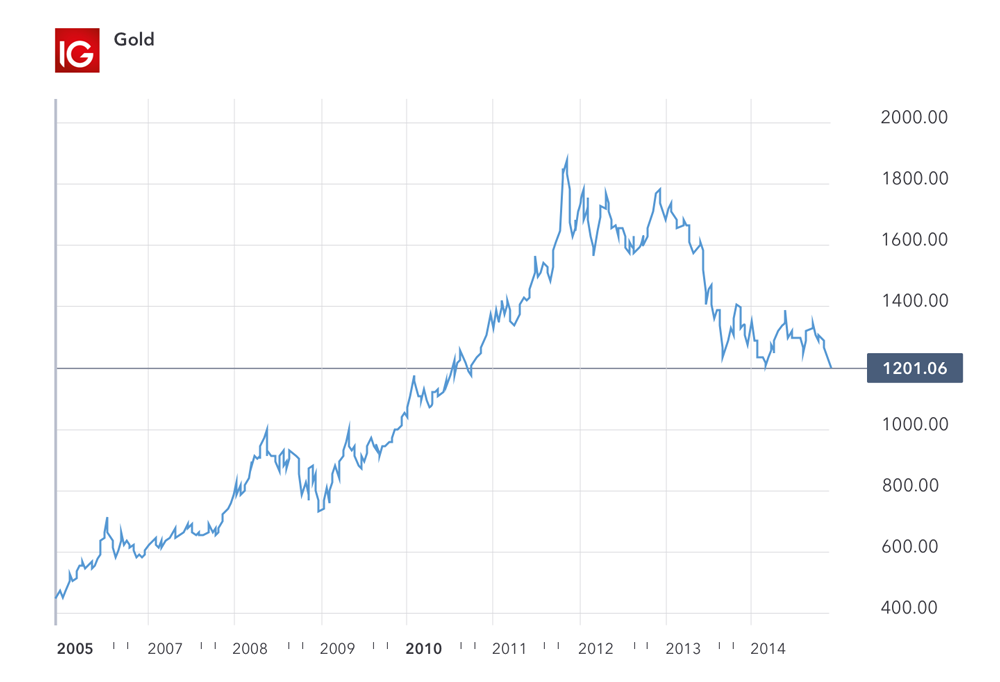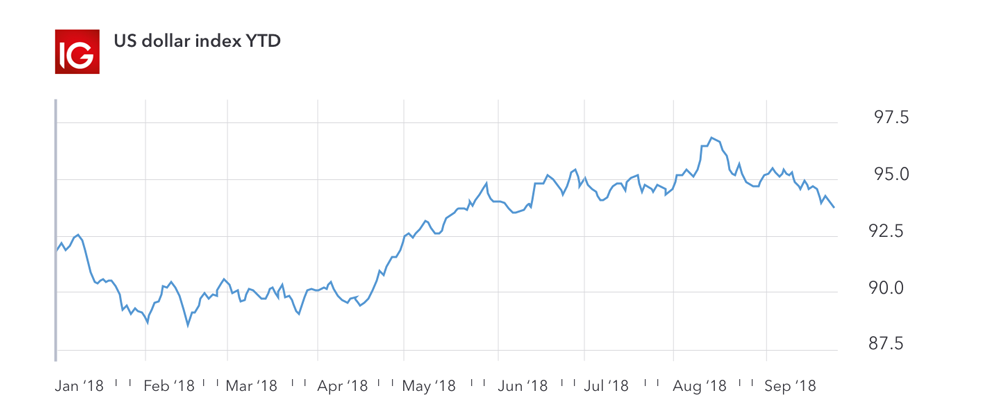What are safe-haven assets and how do you trade them?
Safe-haven assets are used by investors to limit their exposure during times of market instability. If traders identify which assets are likely to appreciate while others decline, they can prepare themselves for market movements.

What are safe-haven assets?
A safe-haven asset is a financial instrument that is expected to retain, or even gain value during periods of economic downturn. These assets are uncorrelated or negatively correlated with the economy as a whole, which means that they could appreciate in the event of a market crash.
There are certain characteristics that assets often have that contribute to their reputation as a safe-haven, which include:
- Liquidity: the asset needs to be easily convertible to cash, at any time
- Functionality: the asset needs to have a use that will continually provide long-term demand
- Limited supply: the growth of supply should never outweigh the demand
- Certainty of demand: the asset is unlikely to be replaced or become outdated
- Permanence: the asset should not decay or rot over time
Not every safe-haven will have all of these characteristics, so investors have to make a judgement about the most suitable safe haven for the economic climate. It is important to remember that what makes a good safe-haven for one market downturn may not show the same results in another, so investors have to be clear about what they are looking to gain from using safe-haven investments.
How to trade safe-haven assets
Market downturns are an inevitable part of market cycles, which means that it is in an investor’s best interest to prepare themselves for them as much as possible.
In times of financial crisis, assets that are viewed as safe-havens tend to outperform the vast majority of markets. Although safe havens are primarily used by investors to protect the value of their portfolio, it is important for traders to be able to identify safe-haven assets, and use this understanding to anticipate price movements and implement their own strategies.
For example, the move out of ‘riskier’ assets could cause a sudden drop in the market price as investors flock to safe-havens, which means that you might consider getting out of any long positions or going short. But if you’re confident that you can identify the safe-havens of the moment, then there is the potential to profit from rising prices.
There is no definitive way to trade the patterns of safe-haven assets, as it all depends on your motivation. But whether you are looking to take advantage of price movements or adjust their own positions to protect themselves from falling prices, it is crucial to understand the prevailing market sentiment surrounding safe-havens.
Examples of safe-haven assets
Popular safe-havens can change over time, so it is important to keep up with investment trends. However, there are a few safe-havens that have remained favourites over the years, including:
Gold
When people think of a safe-haven, they will most likely think of gold. As a physical commodity, the price of gold is not often influenced by the decisions of central banks on interest rates, and unlike paper currencies, its supply cannot be manipulated by actions such as printing.
Perhaps the strongest example of gold as a safe-haven was following the 2008 global financial crisis. The influx of investment caused the price of gold to rise by nearly 24% during 2009 alone, for example, and it continued this upward trajectory into 2011.

Many consider the decision to buy gold a behavioural bias, based on gold’s history of backing currencies and as a store of value. The theory goes that because gold has historically been considered a safe-haven, when there are signs of significant market collapse, investors swarm to the precious metal. Gold as a safe-haven has become a self-fulfilling prophecy.
Ready to trade gold? Open a live account with IG.
Government bonds
Government bonds are essentially a fixed term ‘I owe you’ from a government, which have periodic interest payments – treasury bills and notes are a type of bond. The only difference between them is the amount of time before you will be reimbursed in full. Treasury bills have maturities of a year or less, while treasury bonds can have maturities of ten years or more.
Investors tend to have more confidence in bonds issued by governments of developed economies – the most popular are US treasury bills. Their status as a safe-haven is based on the credit status of the US government, and the high quality of income in US dollars. With such a stable income behind the asset, investors consider government bonds to be a risk-free safe-haven, especially because anything invested will be repaid in full once the bill has matured.
For example, in February 2018, stocks plunged due to rising bond yields and ironically sent investors running to US Treasury bonds as a safe-haven.
Practise trading on government bond prices using an IG demo account.
US dollar
For over 50 years, the US dollar has been one of the most popular safe-havens during economic downturns. It exhibits a number of safe-haven characteristics – most crucially, it is the most liquid currency on the forex market.
This confidence in the US dollar came from the 1944 Bretton Woods agreement, which introduced the fixed currency system and made the dollar the world’s primary reserve currency. Even after this system was abolished, the US dollar retained its position as a safe-haven because it represented the world’s largest economy.
Although many thought the dollar’s status as a safe-haven would be damaged by increased volatility, caused by US President Donald Trump’s controversial politics, it would seem that it is still benefitting from safe-haven flows. For example, although trade tensions caused fluctuations across stock markets and commodities, the US Dollar Index saw an increase of 5.29% between January and August 2018.
Start trading the US dollar by opening a live trading account with IG.

Japanese yen
The Japanese yen is thought of as a safe-haven as it often appreciates against the dollar when US stocks and government bonds experience volatility.
Post-World War II, the Japanese economy was restructured, which enabled it to catch up with other global economies. The Bank of Japan (BoJ) became highly respected and the yen was established as a major global currency. Despite continued interventions from the government, the liquidity of the yen has continued to attract investors in times of financial distress.
The yen earned its reputation as a safe-haven due to Japan’s high trade surplus versus its debt. The value of foreign assets held by Japanese investors is far higher than Japanese assets owed by foreign investors – this means that when markets become ‘risk off’, money moves out of other currencies and back into domestic markets, which strengthens the yen.
Another part of the reason that the yen continues to act as a safe-haven during periods of market turbulence, is because everyone believes that it is. In a similar way to gold, it has become a self-fulfilling prophecy.
Practise trading the Japanese yen using an IG demo account.
Swiss franc
A study by the central bank of Germany, Deutsche Bundesbank, found that the Swiss franc often appreciated when the global stock market showed signs of financial stress.
Common reasons that investors favour the Swiss franc as a safe-haven currency include the political neutrality of the Swiss government, the strong Swiss economy and their developed banking sector.
The country’s independence from the EU has also made it a popular haven for capital during negative political and economic circumstances. In fact, during the eurozone crisis, so much money was flowing into the franc that the Swiss central bank introduced a temporary currency peg against the euro to try and weaken their domestic currency.
Open a live trading account to start trading the Swiss franc.
Defensive stocks
Investors looking to manage their risk during economic downturns could also choose to turn to defensive stocks, because they tend to perform better than the wider stock market during recessions.
Defensive stocks describe the shares of companies that are involved in providing goods and services such as utilities, consumer staples, food and beverages, and healthcare. They are considered safe-haven assets because they are likely to remain stable due to the constant demand for their products, even in periods of economic instability.
Defensive stocks should not be confused with ‘defence stocks’, which refer to weapons manufacturers and others in the arms trade.
Practise taking a position on the price of defensive stocks with an IG demo account.
IGA, may distribute information/research produced by its respective foreign affiliates within the IG Group of companies pursuant to an arrangement under Regulation 32C of the Financial Advisers Regulations. Where the research is distributed in Singapore to a person who is not an Accredited Investor, Expert Investor or an Institutional Investor, IGA accepts legal responsibility for the contents of the report to such persons only to the extent required by law. Singapore recipients should contact IGA at 6390 5118 for matters arising from, or in connection with the information distributed.
The information/research herein is prepared by IG Asia Pte Ltd (IGA) and its foreign affiliated companies (collectively known as the IG Group) and is intended for general circulation only. It does not take into account the specific investment objectives, financial situation, or particular needs of any particular person. You should take into account your specific investment objectives, financial situation, and particular needs before making a commitment to trade, including seeking advice from an independent financial adviser regarding the suitability of the investment, under a separate engagement, as you deem fit.
Please see important Research Disclaimer.

Trading around Brexit
Find out how the UK’s exit from the EU continues to affect traders, and discover:
- The unique opportunities in a ‘hard’ and ‘soft’ Brexit
- The markets you should be watching
- Everything that’s happened so far

